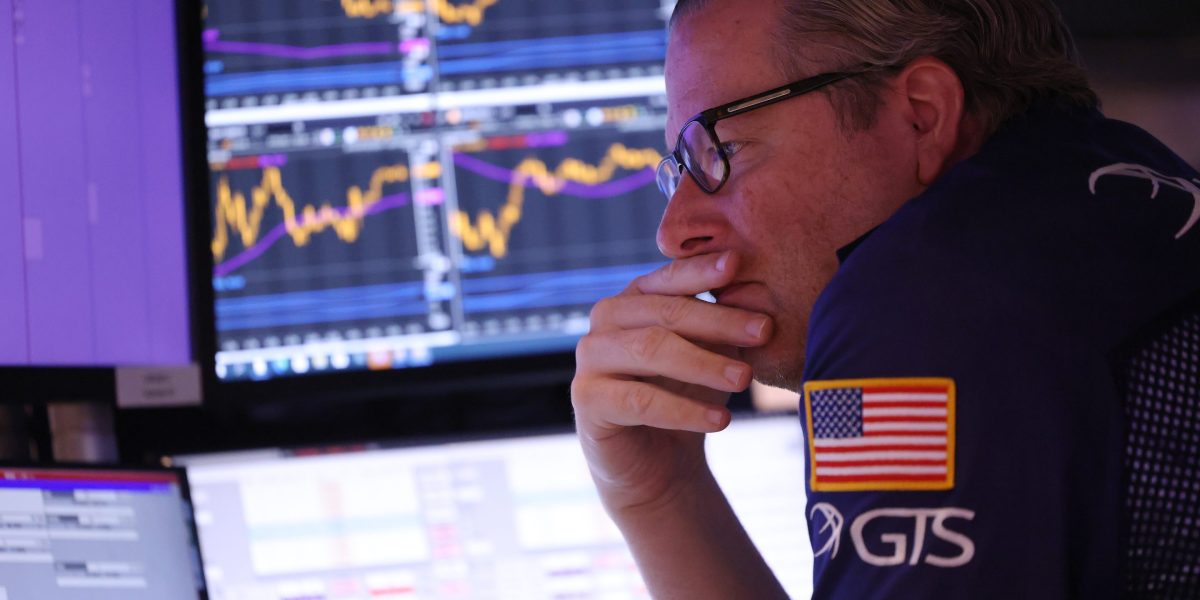
(Bloomberg) — A key segment of the US Treasury yield curve briefly turned positive as weaker-than-anticipated labor-market data bolstered bets on steep interest-rate cuts by the Federal Reserve.
Treasuries jumped on Wednesday — led by shorter-maturity notes that are more sensitive to the Fed’s monetary policy — after US job openings fell in July to the lowest since the start of 2021. That pushed the US two-year note’s yield momentarily below the 10-year note’s for only the second time since 2022 as traders built up wagers on a super-sized rate reduction this month.
“The Fed probably needs to move sooner and maybe even by 50” basis points, said John Fath, managing partner at BTG Pactual Asset Management US LLC. “If they do, then the curve should disinvert completely.”
Interest-rate swaps showed traders have fully priced in a quarter-point rate cut at the Fed policy meeting this month — and a more than 30% chance of a half-point reduction. A total of 107 basis points of easing is expected for the remaining three meetings this year.
Across Wall Street, economists and money managers have been scouring economic data for signs of weakness that would force the Fed to kick off an aggressive rate-cutting cycle.
The decline in openings seen in Wednesday’s data adds to recent evidence the labor market is softening, which has raised concern among Fed officials. Job growth has been slowing, unemployment is rising and job seekers are having greater difficulty finding work, fueling fears about a potential recession.
To Earl Davis, head of fixed income at BMO Global Asset Management, evidence of softness in the US labor market is significant as it “lowers the bar for Fed” to slash rates by a half-point later this month.
“Once they start with 50, it won’t be one-off,” he said. “There’s ample room for them to cut.”
A measure of expected volatility in US rates derived from options on swaps also has surged as traders see more scope for Fed interest-rate cuts.
A More-Normal Yield Curve
The Treasury yield curve also sent a brief signal about the risk of a US downturn.
Historically, bond yield curves slope upward with investors seeking higher yield, or return, for the uncertainty of stashing their cash in longer-maturity Treasuries.
But in March 2022, the yield curve inverted as the Fed kicked off what proved to be its most aggressive tightening cycle in decades. Two-year yields went on to exceed the 10-year by as much as 111 basis points in March 2023, the biggest inversion since the early 1980s.
A restoration of the normal upward slope of the yield curve following a long period of inversion has typically happened when the Fed starts to lower interest rates. Since the Fed tends to ease policy when the economy hits a snag, such disinversion has heightened investors’ concern about recession.
“I like to say that once the yield curve goes positive, it tends to start the clock on the recession,” said Ryan Hayhurst, president of Oklahoma City-based The Baker Group, which advises over 1,000 community banks and credit unions across the country.
For decades, however, strategists and even some Fed officials have downplayed the predictive power of the yield curve.
Prior to the pandemic, many on Wall Street warned the inversion’s recessionary signal was distorted as a result of the central bank keeping rates exceptionally low. And last year, a Bank of America strategist said the inversion was being driven by expectations for a hard landing for inflation as the Fed did its job to rein in price pressures through tight policy.
Now, though, disinversion of the curve is in focus, with two-year yields moving down closer to 10-year’s for months.
“It’s a healthy thing that should be cheered,” said Jerome Schneider, head of short-term portfolio management and funding at Pacific Investment Management Co. “A normal yield curve shape is indicative of a business and monetary-policy climate that is closer to normal and balanced.”
On Aug. 5, the curve also briefly normalized on an intraday basis. While two-year yields quickly moved back above 10-year yields on Wednesday, the remaining gap is less than a basis point.
What Bloomberg strategists say…
“The unreliability of the signal from an inverted yield curve also means a disinversion doesn’t necessarily mean – as it typically used to – a recession is imminent.”
— Simon White, macro strategist. Read more on MLIV.
“The disinversion of the curve makes a lot of sense as we are on the eve of the Fed starting to cut rates,” said Priya Misra, portfolio manager at JPMorgan Asset Management. The amount of easing priced in the market is “consistent with a Fed that wants to normalize rates to preserve the soft landing that we are currently in,” she added.
In a speech at Jackson Hole last month, Fed Chairman Jerome Powell made clear that he intends to prevent the job market from cooling further and that the time has come for the central bank to reduce its key policy rate. That puts attention on an important US labor report on Friday.
The Friday data stands to be the “main determinant” as to whether the Fed opts for a jumbo 50-basis-point cut over a more paced quarter-point approach, said Steven Zeng, a US rates strategist at Deutsche Bank.
In our new special issue, a Wall Street legend gets a radical makeover, a tale of crypto iniquity, misbehaving poultry royalty, and more.
Read the stories.

